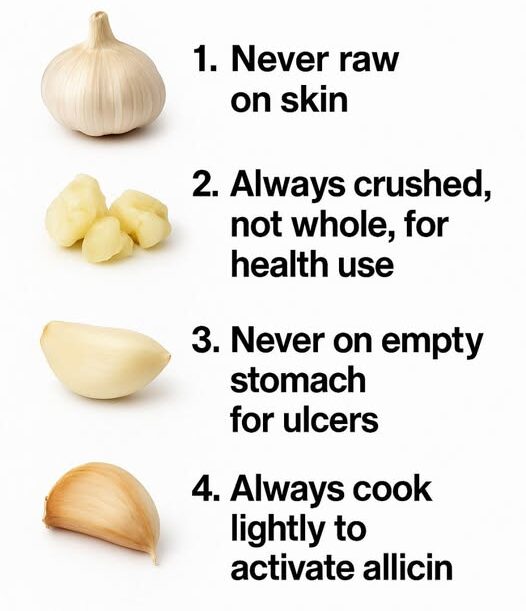Introduction
Garlic is a potent, time-honored household remedy used around the world for culinary and wellness purposes. When used correctly—prepared, diluted, and consumed safely—garlic can support general wellbeing, soothe mild throat discomfort, and add powerful flavor to food. This guide explains the right ways to use garlic as a remedy, warns against unsafe practices, and gives practical recipes and tips you can use at home.
Origin
Garlic (Allium sativum) has been cultivated for at least 5,000 years. Originating in Central Asia, it spread to ancient China, Egypt, Greece, and India where it was used for food, ritual, and medicine. Historical texts record garlic as a treatment for infections, digestive issues, fatigue, and as a general tonic. Its medicinal reputation grew with observed antimicrobial and anti-inflammatory effects, and culinary usage made it ubiquitous in traditional diets.
Cultural Significance
Across cultures, garlic symbolizes strength, protection, and vitality. In Ayurveda and traditional Chinese medicine it appears in remedies and tonics; in Mediterranean cultures it’s a dietary staple associated with heart-healthy diets; in folk traditions it has been used to ward off illness. Modern interest in garlic bridges culinary culture and natural health movements, making it both a comfort food and a home remedy.
Ingredients & Quantity
(Three safe, commonly used preparations)
A — Garlic Honey (immune support / throat soothing — topical ingestion):
- Fresh garlic cloves — 2–3 cloves
- Raw honey — 1 tablespoon
B — Garlic Tea (soothing for mild sore throat / comfort):
- Fresh garlic cloves (crushed) — 1–2 cloves
- Hot water — 250–300 ml (1 cup)
- Lemon — 1 tsp juice (optional)
- Honey — 1 tsp (optional)
C — Garlic-Infused Oil (for culinary use or diluted topical massage around—not on—skin)
Optional Additions
- Lemon (fresh juice) — in tea or honey mixtures for vitamin C and taste
- Fresh ginger — in tea for extra soothing and anti-nausea support
- Black garlic — milder, sweeter alternative for those sensitive to raw garlic
- Carrier oils (coconut, jojoba) — to dilute garlic oil for skin massage (apply around skin, not to open wounds)
- Probiotic foods — pair with garlic in meals to support gut balance
Tips for Success
- Crush or chop garlic and wait 10–15 minutes before using or cooking — this activates allicin, the main beneficial compound.
- Consume with food (olive oil, bread, yogurt) to reduce stomach upset and strong breath.
- Start small (½–1 clove/day) if you’re new to raw garlic. Increase gradually to tolerance.
- Do not place raw garlic on skin or in body cavities (ears, nose, vagina) — it can burn or cause chemical burns and infections.
- If you take blood thinners, are pregnant, or have surgery scheduled, consult a healthcare provider before using medicinal amounts of garlic.
- Store preparations safely — honey mixtures in a cool, dry place; infused oils refrigerated and used within 1–2 weeks.
Instructions
A. Garlic + Honey (daily spoonful)
- Peel and lightly crush 2–3 garlic cloves; wait 10–15 minutes.
- Mash and mix with 1 tablespoon raw honey.
- Take 1 teaspoon once daily while symptomatic (or up to 1 tablespoon per day distributed).
- Store covered in the fridge for up to 1 week.
B. Garlic Tea
- Crush 1–2 cloves and wait 10–15 minutes.
- Pour 1 cup hot (not boiling) water over garlic; steep 5–10 minutes.
- Strain if desired; add lemon and honey to taste.
- Sip warm. Up to 2 cups/day.
C. Garlic-Infused Oil (culinary / diluted topical use around skin)
- Gently warm ½ cup oil and 2–3 crushed cloves over low heat for 5–10 minutes (do not boil).
- Cool and strain; store refrigerated and use within 1–2 weeks.
- Use for cooking or dilute with a carrier oil and apply around the skin (not on broken skin; do not use inside body openings).
Description
The therapeutic value of garlic comes mainly from allicin, produced when garlic cells are damaged (crushing/chopping). Allicin and related sulfur compounds are associated with antimicrobial and anti-inflammatory properties in laboratory studies. Culinary-scale doses provide flavor and mild biologic effects; high medicinal doses can interact with medications and cause side effects (stomach upset, bleeding risk). Proper preparation (crushing + resting) maximizes beneficial compounds while safe consumption minimizes harm.
Nutritional Information
(typical per 1 medium raw clove, ~3 g)
- Calories: ~4
- Carbohydrates: ~1 g
- Protein: ~0.2 g
- Fat: 0 g
- Fiber: ~0.06 g
- Vitamin C: small amount
- Manganese: trace amounts
- Other: sulfur compounds (allicin precursor), trace B-vitamins
Garlic is low-calorie but rich in bioactive sulfur compounds that contribute to its characteristic aroma and potential health effects.
Conclusion
Garlic is an effective and time-tested culinary and wellness ingredient when used correctly. The benefits are best obtained through ingestion (raw or cooked), gentle preparations like garlic tea or garlic-honey mixtures, and culinary regular use. Avoid harmful practices such as inserting raw garlic into body cavities or applying it undiluted to sensitive skin. When used thoughtfully, garlic can be a safe, affordable, and enjoyable part of a healthful routine.
Recommendation
- For general wellness: incorporate garlic into daily cooking (1 clove/day is a reasonable starting point).
- For short-term symptomatic support (cold, sore throat): try garlic tea or a garlic-honey spoonful as described for a few days.
- Consult a healthcare professional before using therapeutic quantities if you: take anticoagulants, are pregnant, have planned surgery soon, have gastroesophageal reflux, or have a known garlic/allium allergy.
- Prefer black garlic or cooked garlic if you have a sensitive stomach.
Embracing Healthful Indulgence
Using garlic the right way honors its long history and culinary joy. Treat garlic as a flavorful ally: savor it in soups, sauces, and dressings, or enjoy a warming garlic tea when you need comfort. These practices combine simple, mindful self-care with practical safety—so you get the benefits without the risks. A small clove each day can be both a delicious indulgence and a gentle nod to centuries of natural medicine.
